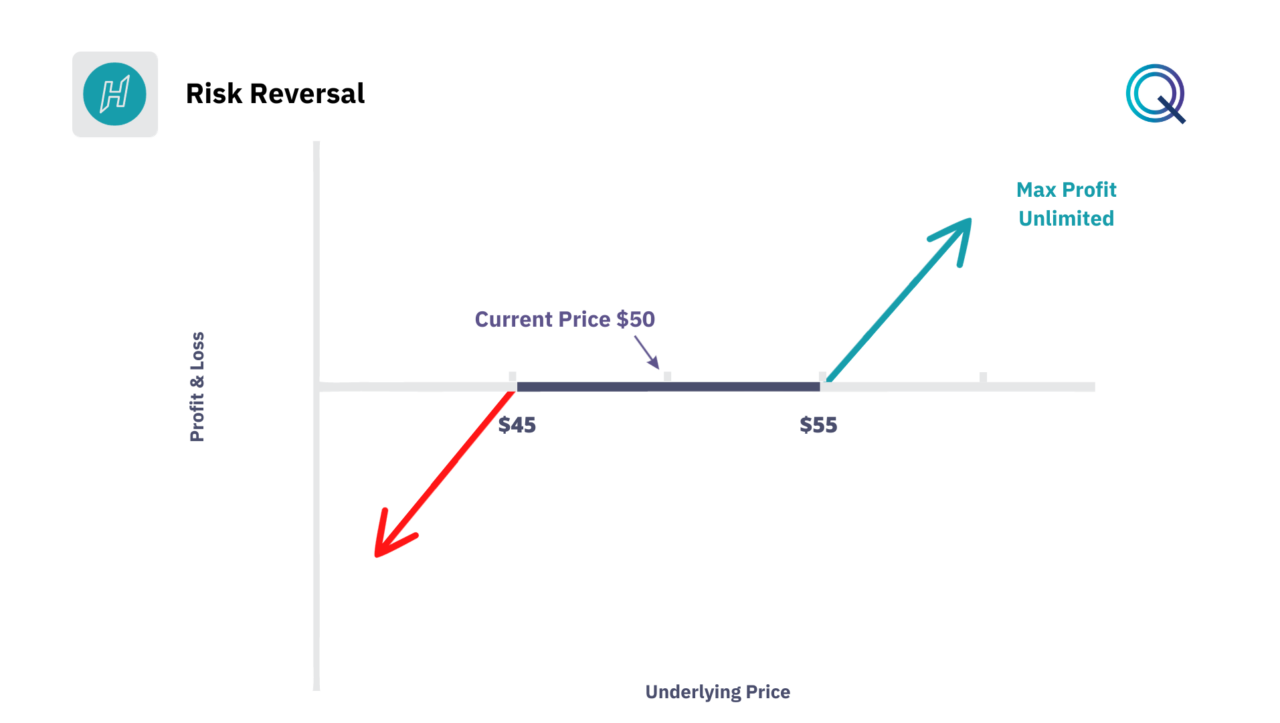Risk Reversal

Among the hedging strategies, we find the Risk Reversal Strategy. The strategy consists of buying an out-of-the-money call and selling an out-of-the-money put. It is a combination of a Long Call and a Short Put.
- By selling the put option, the trader receives a premium that can be used to finance the purchase of the call.
- If the cost of the call is higher than the premium received for the sale of the put, this strategy will result in a debit.
- However, if the sale of the put generates a premium higher than the cost of buying the call, we have a credit strategy.
- This strategy is also called a “Synthetic Long” as we have a bullish view on the underlying asset, but instead of buying shares, we use options.
When we use this strategy, we must carefully analyze the Greeks and the Skew.
- Out-of-the-money put options typically have a higher implied volatility compared to out-of-the-money call options. There is usually a higher demand for puts for protection.
- We are, therefore, selling options with higher implied volatility and buying options with lower implied volatility.
- Traders use this strategy betting on the change in Skew or the volatility surface.
When to use the Risk Reversal
We can use this strategy when we are very bullish on a stock but do not want to employ all the capital to go long on the underlying or do not want to pay the full premium. In this case, by selling a put, we can receive a premium that can partly or totally finance the call.
If the market has bottomed out and we think it will start being bullish again, then we can limit the risk of being assigned on the put leg and benefit from the increase in value of the out-of-the-money calls.
If a stock has suffered significant losses, we can implement this strategy. With a medium-term horizon, we can achieve significant returns if the stock bounces back and gains upward momentum. This strategy has the advantage of being a cost-effective strategy that can offer attractive returns if the market moves. However, it carries risks if the underlying continues to decline.
Payoff Diagram of the Risk Reversal Strategy
Let’s look at the payoff of the Risk Reversal Strategy. In this example, we are interested in a stock quoting at $50. We buy an out-of-the-money call at $55 and sell an out-of-the-money put at $45. Let’s assume that this strategy results in a debit of $1. The breakeven point in this case is represented by the call strike + the debit paid, which is $56.
- The maximum profit is unlimited.
- The maximum loss is significant and is represented by the difference between the put strike and zero. If the underlying falls below the put strike of $45 at expiration, we are obligated to buy 100 shares of the underlying at $45, for a total exposure of $4,500. If the stock goes to zero, we will lose our entire exposure.

Considerations on the Risk Reversal
There are certain factors we need to manage when using this strategy:
- Bullish Sentiment. Risk Reversal is particularly suitable for situations where an investor has strong confidence in the bullish prospects of an underlying asset. It’s a leveraged play that can amplify gains without the capital outlay required to purchase the stock outright.
- Volatility. Investors might use Risk Reversals to capitalize on discrepancies between implied volatility levels of puts and calls. If an investor believes that the market is overstating the probability of a downside move (reflected in higher put premiums), selling puts and buying calls can be profitable if the anticipated downside risk does not materialize.
- Earnings and Events. Before a major announcement or earnings report, if an investor believes that the news will be positive, a Risk Reversal can be a strategic play to gain exposure to the upside while still providing some downside protection if the put sold is not too far out-of-the-money.
- Margin Requirements, When selling a put, investors must be aware of the margin requirements, which can be high. If the market moves against the position, the margin call could force the investor to liquidate positions to cover the margins.
- Assignment Risk. There is always a risk of assignment on the short put, meaning the investor must have liquidity to purchase the underlying asset if it falls below the strike price.
- Downside Protection. While Risk Reversal can finance the purchase of a call, it does not provide the same level of downside protection as a Collar Strategy. If the stock drops, the losses on the short put could be very high.
- Skew Fluctuations. The strategy can benefit from changes in skew. If the skew flattens or inverts, the value of the put option sold may decrease faster than the call option bought, which can be profitable.
- Interest Rates. Changes in interest rates can affect option pricing due to their impact on cost of carry. This is a factor to be considered when entering a long-term Risk Reversal position.
- Rolling the Position. If the market moves in his favor, the investor may roll the short put to a higher strike or extend the expiration to collect more premium and finance the purchase of new calls, maintaining a bullish position.
- Concentration Risk. Using Risk Reversal on a single stock can lead to concentration risk in a portfolio. Diversification across different assets or using index options can help mitigate this.
- Complementary Strategies. Risk Reversal can be used in conjunction with other strategies for a more comprehensive risk management approach. For example, an investor might use a Risk Reversal for bullish exposure while also using protective puts on other holdings as a hedge.
We cover this in more details in our Academy.
Conclusion
In conclusion, while the Risk Reversal strategy offers an asymmetrical risk-return profile that can be attractive in bullish scenarios, it comes with significant risks that must be actively managed.
To recap:
- The Risk Reversal Strategy is a hedging strategy. We use options to take exposure on the underlying.
- The strategy has unlimited profit.
- We have a bullish view on the underlying and use options to take exposure.
- The maximum loss can be significant.
Other Hedging Strategies with Options
Here are other hedging strategies with Options:
